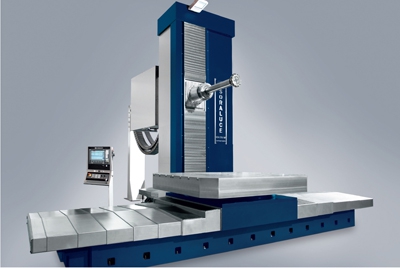
Soraluce America presents the KB-150-WR horizontal boring machine. This machine is a T-Type machine that gives customers access to maximum efficiency for multi-face machining of large work pieces. The KB-150-WR horizontal boring machine is a robust, precision solution that changes the game in milling and boring by providing an efficient and durable state-of-the-art machine that can meet a wide assortment of machining requirements, according to the company.
The combination of top quality cast iron elements, linear roller guide ways with a hydrostatic dampening system provides high dynamics that improve the machine's performance. The quill's exceptional thermal stability is due to three complete cooling systems for the bearings, the gearbox and the spindle motor.
The highly rigid quill spindle is mounted in large angular contact bearings that are lubricated with an air-oil system. This spindle design is matched to an oversized ram to provide for efficient machining in extended reach applications. In addition, the machine undergoes specific reliability and precision testing, pursuant to SORALUCE'S demanding standards.
This machine offers high performance with 787 ipm rapid rates, high axis feed forces, a 5.9" quill with 31.5" of travel, and a large ram with 40" of stroke. All of these combine to provide heavy stock removal capacity with high rigidity.
Contact Details
Related Glossary Terms
- boring
boring
Enlarging a hole that already has been drilled or cored. Generally, it is an operation of truing the previously drilled hole with a single-point, lathe-type tool. Boring is essentially internal turning, in that usually a single-point cutting tool forms the internal shape. Some tools are available with two cutting edges to balance cutting forces.
- boring machine
boring machine
Similar to a turning machine except that the cutting tool (single-point or multiple-cutting-edge), rather than the workpiece, rotates to perform internal cuts. However, boring can be accomplished by holding the tool stationary and turning the workpiece. Takes a variety of vertical, slanted and horizontal forms, and has one or more spindles. Typically a large, powerful machine, it can readily hold tolerances to 0.0001". See jig boring; lathe; turning machine.
- feed
feed
Rate of change of position of the tool as a whole, relative to the workpiece while cutting.
- gang cutting ( milling)
gang cutting ( milling)
Machining with several cutters mounted on a single arbor, generally for simultaneous cutting.
- inches per minute ( ipm)
inches per minute ( ipm)
Value that refers to how far the workpiece or cutter advances linearly in 1 minute, defined as: ipm = ipt 5 number of effective teeth 5 rpm. Also known as the table feed or machine feed.
- milling
milling
Machining operation in which metal or other material is removed by applying power to a rotating cutter. In vertical milling, the cutting tool is mounted vertically on the spindle. In horizontal milling, the cutting tool is mounted horizontally, either directly on the spindle or on an arbor. Horizontal milling is further broken down into conventional milling, where the cutter rotates opposite the direction of feed, or “up” into the workpiece; and climb milling, where the cutter rotates in the direction of feed, or “down” into the workpiece. Milling operations include plane or surface milling, endmilling, facemilling, angle milling, form milling and profiling.






